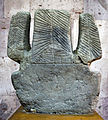Hripsime Djanpoladian
Hripsime Djanpoladian (Armenian: Հռիփսիմե Ջանփոլադյան, Russian: Рипсимэ Микаэловна Джанполадян-Пиотровская, 26 August 1918 - 1 September 2004) was an archaeologist and epigrapher originally from Armenia.
Biography
[edit]Djanpoladian was born in 1918 on the way to Tbilisi, as her family fled from the Armenian genocide.[1] Her parents were Michael and Iranianak,[1] who already had a son Gurgen.[2] The family were wealthy and their money came from Nakhichevan salt mines.[1]
After the establishment of Soviet power in Armenia, the family moved to Yerevan. After finishing school, Djanpoladian chose to study archaeology at Yerevan State University.[3] After graduation in 1940,[4] she took part in excavations at the Karmir-Blur hill of the Teishebaini fortress city.[3] During these excavations she met her future husband, Boris Piotrovsky.[3] Djanpoladian had excavated a figurine of the Urartian god of war, a culture which became Piotrovsky's specialism.[3] They married in Yerevan in 1944, and their son Mikhail Piotrovsky was born there.[3]
After a long illness, Djanpoladian died in 2004 and was buried in Smolensk Cemetery next to her husband.[5]
Career
[edit]Djanpoladian graduated with a doctorate in archaeology in 1948 entitled “Mkhitar Gosh and the Monastery of Nor Getik", which examined many of the inscriptions there.[4] This interest in epigraphy was to continue; by 1977 she and Suren Avagyan published a new catalogue of Armenian inscriptions.[6] She worked for the Institute of Archeology of the Academy of Arts of the USSR and in the East Department of the Hermitage Museum.[3] In addition to her own research into medieval Armenia, she also edited all of her husband's publications, including an encyclopedic history of the Hermitage, his diaries, travel notes and autobiography.[3]
Dvin Excavations
[edit]Djanpoladian's work on the 1951 Dvin Excavations demonstrated that it was an important centre for medieval glass production.[4] This work developed into an exploration of the glass industry in Dvin from the ninth to thirteenth centuries, with particular focus on trade with the Middle East.[7] She was able to demonstrate that Armenian craftsmen were copying Syrian glassware.[8]
-
Husband: Boris Piotrovsky
-
Son: Mikhail Piotrovsky
-
Karmir Blur Town
-
Karmir Blur Idol
-
Mkhitar Gosh's Grave
-
Ruins of Dvin, 2019
References
[edit]- ^ a b c "Ruben Angaladian". www.bvahan.com. Retrieved 2 April 2020.
- ^ "Михаил Пиотровский - историю жизни читать тут". AURORA PRIZE (in Russian). Archived from the original on 9 March 2018. Retrieved 2 April 2020.
- ^ a b c d e f g "Скончалась Рипсимэ Джанполадян-Пиотровская". www.museum.ru. Retrieved 2 April 2020.
- ^ a b c "Hripsime Janpoladyan's 100th Birthday" (PDF). Historical-Philological Magazine.
- ^ "ПИОТРОВСКИЙ Борис Борисович (1908-1990)". funeral-spb.narod.ru. Retrieved 2 April 2020.
- ^ Ավագյան, Սուրեն Արտեմի; Ջանփոլադյան, Հռիփսիմե Միքայելի; Հնագիտության և ազգագրության ինստիտուտ ՀՍՍՀ ԳԱ, eds. (1977). Դիվան հայ վիմագրության ։: Պր. 6-րդ ։ Իջևանի շրջան. Երևան ։: ՀՍՍՀ ԳԱ հրատ.
- ^ Ջանփոլադյան, Հռիփսիմե Միքայելի (1974). Առաքելյան, Բաբկեն Նիկոլայի (ed.). Դվինի միջնադարյան ապակին IX-XIII դդ. =: Средневековое стекло Двина IX-XIII вв. Հայաստանի հնագիտական հուշարձանները № 7. ՀՍՍՀ ԳԱԱ. Երևան: ՀՍՍՀ ԳԱ հրատարակչություն.
- ^ ""Двор у нас был чудесный": Михаил Пиотровский о детстве в Ереване". Армянский музей Москвы и культуры наций (in Russian). Retrieved 2 April 2020.







